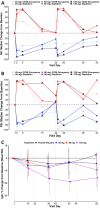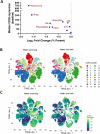Mezagitamab in systemic lupus erythematosus: clinical and mechanistic findings of CD38 inhibition in an autoimmune disease
- PMID: 38453421
- PMCID: PMC10921479
- DOI: 10.1136/lupus-2023-001112
Mezagitamab in systemic lupus erythematosus: clinical and mechanistic findings of CD38 inhibition in an autoimmune disease
Abstract
Objective: To evaluate safety and mechanism of action of mezagitamab (TAK-079), an anti-CD38 monoclonal antibody, in patients with moderate to severe systemic lupus erythematosus (SLE).
Methods: A phase 1b double-blind, placebo-controlled, multicentre study was conducted in patients with SLE receiving standard background therapy. Eligible patients were adults who met the 2012 SLICC or ACR criteria for diagnosis, had a baseline SLE Disease Activity Index 2000 (SLEDAI-2K) score of ≥6 and were positive for anti-double-stranded DNA antibodies and/or anti-extractable nuclear antigens antibodies. Patients received 45 mg, 90 mg or 135 mg of mezagitamab or placebo every 3 weeks over 12 weeks. Primary endpoints were safety and tolerability. Secondary endpoints included pharmacokinetics and pharmacodynamics. Exploratory assessments included disease activity scales, deep immune profiling and interferon pathway analysis.
Results: 22 patients received at least one dose of either mezagitamab or placebo. In patients exposed to mezagitamab (n=17), drug was well tolerated. Adverse event (AEs) were balanced across treatment groups, with no treatment emergent AEs exceeding grade 2. Responder analyses for Cutaneous Lupus Erythematosus Disease Area and Severity Index (CLASI) and SLEDAI-2K did not reveal any observable differences across treatment groups. However, there was a trend for more profound skin responses among patients with higher CLASI scores (>10) at baseline. Pharmacodynamic analysis showed median CD38 receptor occupancy up to 88.4% on CD38+ natural killer cells with concurrent depletion of these cells up to 90% in the 135 mg group. Mean reductions in IgG and autoantibodies were less than 20% in all dose groups. Cytometry by time of flight and type 1 interferon gene analysis revealed unique fingerprints that are indicative of a broad immune landscape shift following CD38 targeting.
Conclusions: Mezagitamab had a favourable safety profile in patients with moderate to severe SLE and elicited a pharmacodynamic effect consistent with CD38+ cell depletion. These findings reveal novel insights into the drug's mechanism of action and support the continued investigation of mezagitamab in autoimmune diseases.
Keywords: B-lymphocytes; antibodies; biological products; interferon type I; systemic lupus erythematosus.
© Author(s) (or their employer(s)) 2024. Re-use permitted under CC BY. Published by BMJ.
Conflict of interest statement
Competing interests: SRPM and NMW were employees of Takeda Development Center Americas, Inc., each with stock ownership interests in Takeda at the time the study was conducted. VAN, CM, FH, DB and ETM are employees of Takeda Development Center Americas, Inc., each with stock ownership interest in Takeda. RAF is a research consultant for Takeda Development Center Americas, Inc.
Figures



References
Publication types
MeSH terms
Substances
LinkOut - more resources
Full Text Sources
Medical
Research Materials
Miscellaneous
